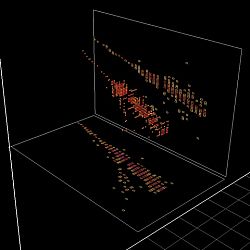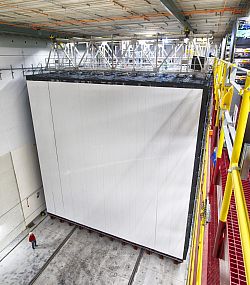Physicists visit neutrino experiment site
Physicists from the University of Sussex are in the USA this month helping to set up the largest-ever experiment into neutrinos to be built there, just weeks after its neutrino detector, which is still under construction, recorded its first three-dimensional images of particles.
 This 3D image shows a cosmic-ray muon producing a large shower of energy as it passes through the NOvA far detector in Minnesota. Image courtesy NOvA collaboration.
This 3D image shows a cosmic-ray muon producing a large shower of energy as it passes through the NOvA far detector in Minnesota. Image courtesy NOvA collaboration.
 When completed, the NOvA detector will comprise 28 detector blocks, each measuring about 50 feet tall, 50 feet wide and 6 feet deep. Photo by Fermilab.
When completed, the NOvA detector will comprise 28 detector blocks, each measuring about 50 feet tall, 50 feet wide and 6 feet deep. Photo by Fermilab.
Using the first completed section of the $200 million NOvA neutrino detector, scientists have begun collecting data from cosmic rays – particles produced by a constant rain of atomic nuclei falling on the Earth’s atmosphere from space.
A Sussex team, led by Dr Jeff Hartnell, will join scientists from around the world at the NOvA experiment’s headquarters near Chicago from 18 to 21 April for a collaboration meeting with some of the 180 scientists and engineers who are taking part.
The NOvA experiment, an international research project, is investigating fundamental issues about the universe and our existence, such as why there is more matter than antimatter.
Scientists' goal for the completed detector is to use it to discover properties of mysterious fundamental particles called neutrinos. Neutrinos are as abundant as cosmic rays in the atmosphere, but they have barely any mass and interact much more rarely with other matter. Many of the neutrinos around today are thought to have originated in the big bang.
"The more we know about neutrinos, the more we know about the early universe and about how our world works at its most basic level," said NOvA co-spokesperson Professor Gary Feldman of Harvard University.
The Fermi National Accelerator Laboratory (Fermilab), which manages the NOvA project, will generate a beam of neutrinos to send to a 200-foot-long detector in Ash River, Minnesota, near the Canadian border. The particles will complete the 500-mile trip from near Chicago in less than three milliseconds. Because neutrinos rarely interact with other matter, they travel straight through the Earth without a tunnel.
Scientists will detect a small fraction of the neutrinos in a near-detector at Fermilab and in the larger far-detector in Minnesota, looking for signals that the neutrinos are changing from one type to another on their trip.
Dr Hartnell, Lecturer in Experimental Particle Physics, and two post-doctoral researchers at Sussex – Dr Matthew Tamsett and Dr Abbey Waldron – are helping to get the detector ready for use.
Dr Hartnell says: “It's a really exciting time to be working on the experiment; after a decade of planning the detector is now coming together fast.
“Given all the planning and the fact that the experiment will run for a decade, it's only for a few brief years in a whole career that we get to start taking data with a new particle physics detector.
“I'm very much looking forward to detecting our first neutrino in the summer and then producing our first physics results in 2014.”
The Sussex team is working on several aspects of the experiment, such as preparing the data-acquisition system.
Dr Waldron is already in Chicago calibrating the detector and Dr Tamsett will join her on Monday (8 April), when he will begin working on the trigger – often called the brains of the detector. The trigger will help the scientists to distinguish the neutrinos interacting in the detector from the hundreds of thousands of cosmic rays passing through the detector every second.
They will also shortly start to take shifts operating the detector, taking control from the Sussex campus. In particular they will take shifts in the morning so that their American colleagues don't have to be up at 4am!
The team will return Stateside in the summer to help build the smaller detector near Chicago.
Dr Hartnell was last summer awarded a €1.5 million grant by the European Research Council (ERC), which enabled the team to join the experiment.
The detector is due to be completed in early 2014, and the first run of experiments will last for six years.
You can watch on YouTube a time-lapse video of the installation of the first of 28 detector blocks in Ash River.
